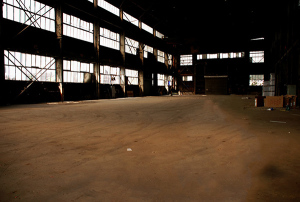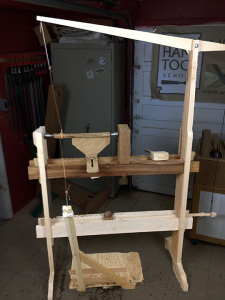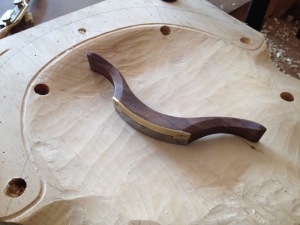What If Your Shop Were MUCH Bigger
 Shop space is one thing we can never seem to have enough of. But we deal with tiny spaces and build highly efficient workflows to get things done. What if space were not an issue? What would you do differently in your shop? Would you buy more tools to fill the space, or just spread out a lot more? The answers to this question might just be wishful thinking, but they also might provide some key insights into how to structure your real life shop today.
Shop space is one thing we can never seem to have enough of. But we deal with tiny spaces and build highly efficient workflows to get things done. What if space were not an issue? What would you do differently in your shop? Would you buy more tools to fill the space, or just spread out a lot more? The answers to this question might just be wishful thinking, but they also might provide some key insights into how to structure your real life shop today.
I would spread out, I don’t really need any more tools. Though I must admit that if space weren’t an issue that there might be a few power tools finding their way back into the shop. I got rid of quite a few of them just because they rarely got used and they space they took up didn’t justify their existence. These examples are rare but usually they relate to more DIY type projects where it is less about joinery and more about nails and caulk. Specifically a place to set up my track saw for plywood projects and a place for my dust extractor and random orbit sander come to mind. Certainly a dedicated space for my 20″ planer would be welcome.
Room to Spread Out
 Mostly though this dream shop space would allow me to segment my work and spread out. Things like creating a lathe corner where I could place racks for my turning tools and chucks and other accessories. I could even set up all of my lathes with some dust collection specific to them as well. It would be cool to have the space to run an actual spring pole along the ceiling too.
Mostly though this dream shop space would allow me to segment my work and spread out. Things like creating a lathe corner where I could place racks for my turning tools and chucks and other accessories. I could even set up all of my lathes with some dust collection specific to them as well. It would be cool to have the space to run an actual spring pole along the ceiling too.
I could ditch my shaving pony (while very effective) and build a shave horse and small bench specific to Windsors and other chair styles. I could keep all of my chair specific tools like inshaves, drawknives, travisher, reamers, steam box, etc in cases or racks right around the bench and horse and call it the chair making corner.
I would wall off a section and make a finishing room with a dedicated ventilation system and a central rotating finishing table. I’d move my finishes into their own cabinet and keep all the other sundries like rags and filters and HVLP cleaning products right in the same room.
For the main part of the shop I would set it up with my workbench and joinery bench and keep my saws and sawing bench close by. Invariably this area of the shop would get the most attention with organization and creature comforts. Everything would key off the workbench and like my other dedicated areas only the tools I used in that space would be stored nearby.
In other words it would look pretty much like my shop now.
This “what if” exercise is exactly what I went through when I remodeled my shop last summer. What I discovered was that all my dedicated areas would be nice but would only be used in very specific situations and projects. For example when I’m turning that’s all I’m doing and I can assemble my pole lathe or wheel my treadle lathe into a good position. The I turn some chair legs or a stand alone turning project like bowls or small spindle stuff. I can pull out my turning tools and other accessories for that operation and put it all away when I’m done. It is rare that I would ever need to hop onto the lathe for something quick then back over to the workbench so its not a problem to transform my shop into a turning centric set up for the day or even a couple of weeks (typical at Christmas time).
 The same applies for Windsor chairs. I’ve only built 4 of them and I thoroughly enjoy it and plan to do it again. But it is a fairly self contained type of work and I really only need the specific tools and work holding for chairs and I can set it all up and break it all down when the chair is done.
The same applies for Windsor chairs. I’ve only built 4 of them and I thoroughly enjoy it and plan to do it again. But it is a fairly self contained type of work and I really only need the specific tools and work holding for chairs and I can set it all up and break it all down when the chair is done.
You can make the same case for any offshoot of woodworking. Even the specific stuff that would cross into typical furniture making. For instance, if I want to add a carved element or some marquetry the specific tools and sundries to those tasks can come out of storage and then pack back up when I’m done.
This realization was a pretty big deal to me. Maybe its obvious to many but it was liberating to know that it was okay to stick stuff in a box and put it on a shelf in my laundry room or a closet. What’s left is only the stuff that I turn to every day on every project. These every day items are a surprisingly small amount of tools that store in a single cabinet, saw til, a sharpening area, and a cabinet for finishes and glue. So here I sit in a 250 square foot shop with everything I need and a lot of elbow room. I keep thinking I should hang a cabinet here or there to put stuff in and then wonder if I really need it or if I’m just trying to fill the empty spaces.
Its an interesting perspective on the work shop that immediately transforms even the tiniest of spaces into an efficient work place. So while we all dream of cavernous spaces I’d wager to say that very few of us actually need that much space.


